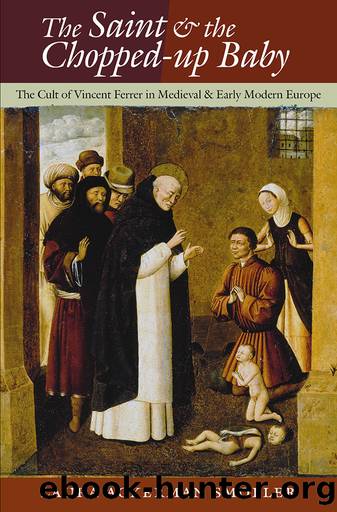The Saint and the Chopped-Up Baby by Laura Ackerman Smoller

Author:Laura Ackerman Smoller [Smoller, Laura Ackerman]
Language: eng
Format: epub
Tags: History, Medieval, Religion, Christianity, Saints & Sainthood, Biography & Autobiography, Religious
ISBN: 9780801470974
Google: T2moAgAAQBAJ
Publisher: Cornell University Press
Published: 2014-01-21T01:10:46+00:00
CHAPTER 5
Competing Stories
Whose Vincent Ferrer Is It Anyway?
When Pietro Ranzanoâs new Life of Vincent Ferrer was approved by the brothers of his order in May 1456, it did not immediately have the effect its author and commissioners must have intended: to stabilize an âofficialâ image of the new saint as a healer of Schism and converter of infidels. Rather, throughout the first half century or so after Vincentâs canonization, there were a number of competing stories told about the saint, both in words and in pictures. The new medium of print helped to keep these various images alive, alongside a still vigorous circulation of manuscript materials. In fact, in what would have been, for Ranzano, a frustrating irony, his Life never appeared in print in its entirety until the seventeenth century, and his fashioning of the new Dominican saint did not begin to reliably inform subsequent portrayals of Vincent until the last decades of the seventeenth century.1 Still, if Ranzano did not succeed early on in imposing a single meaning on the memory of Vincent Ferrer, his efforts did accomplish this much in the decades following Vincentâs canonization: a wide dissemination of the miraculous story of the saint and the chopped-up baby.
Fifteenth-century authors and artists in fact had more information at their disposal than that provided by Pietro Ranzano in his Life and other writings on Vincent. Already by the 1430s, Dominicans hoping to promote Vincentâs sanctity had begun publicizing the preacherâs career, even as crisis prevented the papal curia from devoting its attention to the cause of canonization. A short biography of Vincent embedded in the moral treatise Formicarius (The Anthill ) of the Dominican Joannes Nider, as well as a set of Italian frescoes, is testimony to this early attempt to capture the holy manâs essence. After Vincentâs 1455 canonization, there were also the bull of canonization and the canonization inquests, which by papal order were to be made available for public consultation in Rome at the Dominican headquarters of Santa Maria sopra Minerva. At least two early biographers of Vincent Ferrer besides Ranzano made clear use of the inquests, particularly the miracle-laden Brittany process. And there were still other sources, now lost. A collection of Vincentâs miracles makes reference to an inquest held in Lérida in Aragon in 1451; some of those tales made it into Ranzanoâs and othersâ biographies. Archbishop Antoninus of Florence mentions a âletter of canonizationââmost likely a missive announcing Vincentâs sainthood that circulated among Dominican houses prior to the issuance of the bull of canonization in 1458âan epistle that included at least some enumeration of Vincentâs miracles.2 And there was oral tradition, with its continuing honing of stories about the new saint and accumulating of new ones, as Vincentâs intercession worked fresh miracles for the faithful.
From these various sources, authors and artists pieced together their own Vincent Ferrers, at times in service of a causeâsuch as the promotion of Observant reforms in the Dominican Orderâat times with an eye to nothing more than spinning an engaging and spiritually edifying story.
Download
This site does not store any files on its server. We only index and link to content provided by other sites. Please contact the content providers to delete copyright contents if any and email us, we'll remove relevant links or contents immediately.
Harry Potter and the Goblet Of Fire by J.K. Rowling(3046)
Unfinished: A Memoir by Priyanka Chopra Jonas(2918)
Never by Ken Follett(2884)
The Man Who Died Twice by Richard Osman(2300)
Machine Learning at Scale with H2O by Gregory Keys | David Whiting(2293)
Fairy Tale by Stephen King(2072)
Will by Will Smith(2043)
Rationality by Steven Pinker(1765)
The Storyteller by Dave Grohl(1662)
The Dawn of Everything: A New History of Humanity by David Graeber & David Wengrow(1571)
The Dark Hours by Michael Connelly(1571)
The Stranger in the Lifeboat by Mitch Albom(1532)
Cloud Cuckoo Land by Anthony Doerr(1435)
The Becoming by Nora Roberts(1331)
Friends, Lovers, and the Big Terrible Thing by Matthew Perry(1330)
New Morning Mercies: A Daily Gospel Devotional by Paul David Tripp(1325)
Crying in H Mart by Michelle Zauner(1316)
Einstein: His Life and Universe by Walter Isaacson(1315)
A Short History of War by Jeremy Black(1300)
